Food sensitivities have been on the increase over the past decades and estimates suggest that 60% of the population may have food sensitivities without knowing it [1]. Properly identified food sensitivities and elimination diet based on the food intolerance IgG test can be successfully used to resolve many chronic symptoms.
Over the years in clinical practice we have noticed patients with food sensitivities related symptoms steadily increasing. Therefore, we have been searching for effective therapies and testing a number of approaches, including various elimination diets. These type of diets usually prove to be challenging for both the patients and practitioners and often don’t produce satisfactory results.
Our aim was to find a method where food sensitivities could be identified using a test to guide patients through the tailored elimination diets. After much research and experimentation, we came across IgG testing for food sensitivities developed by Nutrition Cambridge Nutritional Sciences Ltd (i.e. IgG FoodPrint® test) which is a simple blood test that provides information on IgG reactivity through an easy to interpret report. Read more about the test and IgG testing HERE.
It needs to be said that to date the effects of the food specific IgGs on human health have been controversial. However, the vast majority of the previous clinical studies on food-specific IgG sensitivity typically focused on patients with a specific disease. In contrast, our clinical study covered a number of disease categories and symptoms across a wide age range, with the aim to assess therapeutic applications of IgG guided elimination diets in clinical practice.
Early patients’ results were very encouraging showing that food sensitivities testing and elimination diet significantly help to resolve a variety of symptoms. Based on this we made a decision to conduct a clinical study to track patients’ progress over time. It took us over two years to collect and analyse the data, and to write up a fully referenced and statistically analysed clinical study, but the patient results are all worth it! Here’s the link to the full study:
Study title: “Therapeutic use of IgG food sensitivity testing and elimination diet as an effective approach to patient’s care”
Study authors: Joanna Sochan and Dr Nicholas Greene
For the remainder of this post, we’ll provide a summary of steps taken and results achieved.
Study objectives
This clinical study intended to validate the IgG food sensitivity testing for its ability to resolve or alleviate the causes and/or symptoms of our patients who reported a variety of complaints. These were broadly classified into six categories:
- Gut and digestive imbalances
- Skin disorders
- Weight loss
- Autoimmune disorders
- Hormone imbalances
- Other
Patients were classified into the above categories taking into account their chief complaint(s), as specified by them at an initial assessment. In addition to the chief complaint(s), the vast majority of patients also presented with multiple other complaints which were also recorded and monitored during the elimination diet protocol based on the IgG food sensitivity testing.
Study design
The study included a cohort of patients who undertook food sensitivity testing (either one or two tests) and were closely monitored and coached for at least 6 months, utilising a tailored clinical methodology especially designed for the study – see details below.
Methodology
Our study methodology was based on achieving optimal health results for patients. The sequential steps were organised into a clear and feasible sequence, where a patient and a practitioner worked closely together facilitating optimal health and wellness outcomes.
Participants selection criteria
Included in the study were patients who satisfied the following criteria:
- Patients who performed a minimum of two FoodPrint 200+ tests completed within 6 to 8 months of each other (19 patients),
- OR
- Patients who performed the initial FoodPrint 200+ test only and whose symptoms were monitored on a regular basis (minimum of three 3 consultations in 6 months) for at least 6 months on the elimination diet (3 patients)
Based on the above criteria, the study had n=22 participants. Out of all tests performed (98 tests = 100%), 22 patients (22.5%) fulfilled the selection criteria for study participation.
Patients age range was from 17 to 69 years, the group consisted of 13 females and 9 males. For detail description of our methodology and steps refer to the full study report HERE.
Intervention
The aim of the study was to assess the efficacy of IgG food sensitivity testing in order to guide food elimination diets to resolve or decrease various complaints and/or symptoms of the participants.
The study reviewed the nutritional therapies and results of patients who were placed on an elimination diet for treatment of food sensitivities identified by the FoodPrint 200+ IgG test. Based on an initial IgG test, foods causing ELEVATED IgG levels (>30 U/ml) were identified and eliminated from each patient’s diet. Substitute foods were recommended based on the list of NORMAL foods (<23 U/ml) in patient’s results (for detailed explanation refer to the full study report).
Statistical methods
Changes in measured quantities between baseline and retest were tested using paired t-tests and paired Wilcoxon tests. Use of the t-test implicitly assumes normality of the differences between retest and baseline values. This was checked using the Shapiro-Wilk test when needed. A p-value less than 0.05 was regarded as indicating a statistically significant outcome. Statistical analysis was carried out in R version 4.2.1 [1].
[1] R Core Team (2022). R: A language and environment for statistical computing. R Foundation for Statistical Computing, Vienna, Austria. URL https://www.R-project.org/.
Results
Majority of patients who complied with the avoidance of foods identified by the IgG food sensitivity testing demonstrated a marked reduction in sensitivities, and all patient demonstrated a significant reduction in the initial chief complaint(s) as well as other symptoms reported before starting the elimination diet.
Number of IgG sensitivities detected showed a statistically significant decrease between baseline and retest values, by paired t-test (mean decrease = 7.14; 95%CI: 0.94 – 13.3; p = 0.026) and by paired Wilcoxon test (median decrease = 7.50; 95%CI: 0.0004 – 14.5; p = 0.045). A Shapiro-Wilk test application did not reject the assumption of normality of the differences between baseline and retest values (p = 0.497).
Chief complaint severity scores showed a statistically significant decrease between initial and retest values, by paired t-test (mean decrease = 6.95; 95%CI: 6.16 – 7.75; p < 0.001) and by paired Wilcoxon test (median decrease = 7.00; 95%CI 6.00 – 8.00; p < 0.001). A Shapiro-Wilk test application did not reject the assumption of normality of the differences between initial and retest values (p = 0.311).
The initial tests and second tests (retests) of the FoodPrint 200+ IgG tests were compared at the conclusion of the study. The average time between the two tests was 6-8 months. Among the 22 patients, 100% demonstrated sensitivity to one or more of the 10 foods/ food groups that were identified as the most problematic in the study. The 10 food were: egg white (22 patients/100%), nuts (22/100%), barley (22/100%), wheat (21/95%), milk (20/91%), corn (20/91%), cola nut (20/91%), yeast (20/91%), agar agar (16/73%) and soy (12/55%).
Figure 1
Number of elevated IgG sensitivities detected – initial (baseline) and second (retest) IgG results
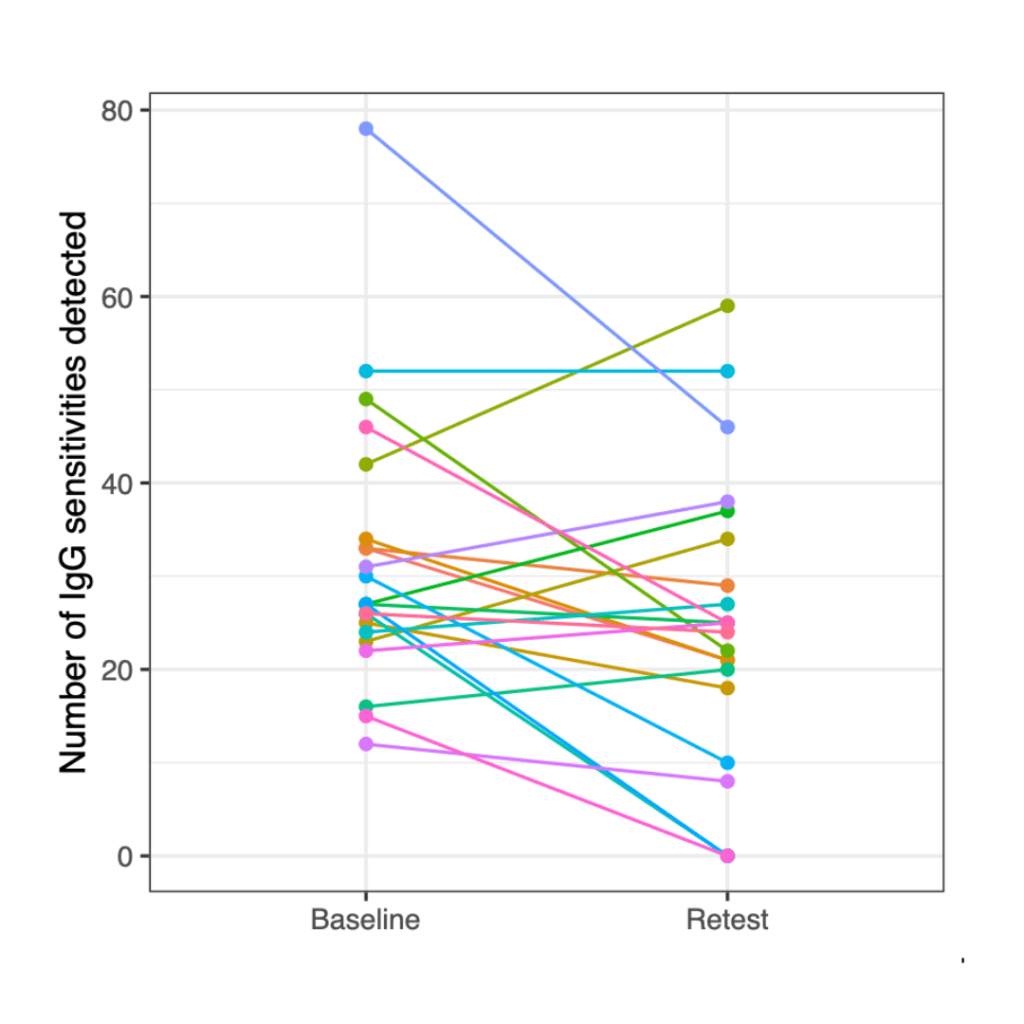
Notably, all patients experienced significant improvements of symptoms regardless of any increases in the number of the IgG antibodies – see Figure 2 below. All patients reported significant improvements in their chief health complaint(s) compared to baseline as illustrated in Figure 2.
As before, each line shows the movement of an individual patient. As can be seen, all the lines slope down, consistent with the statistical test results presented above.
Figure 2
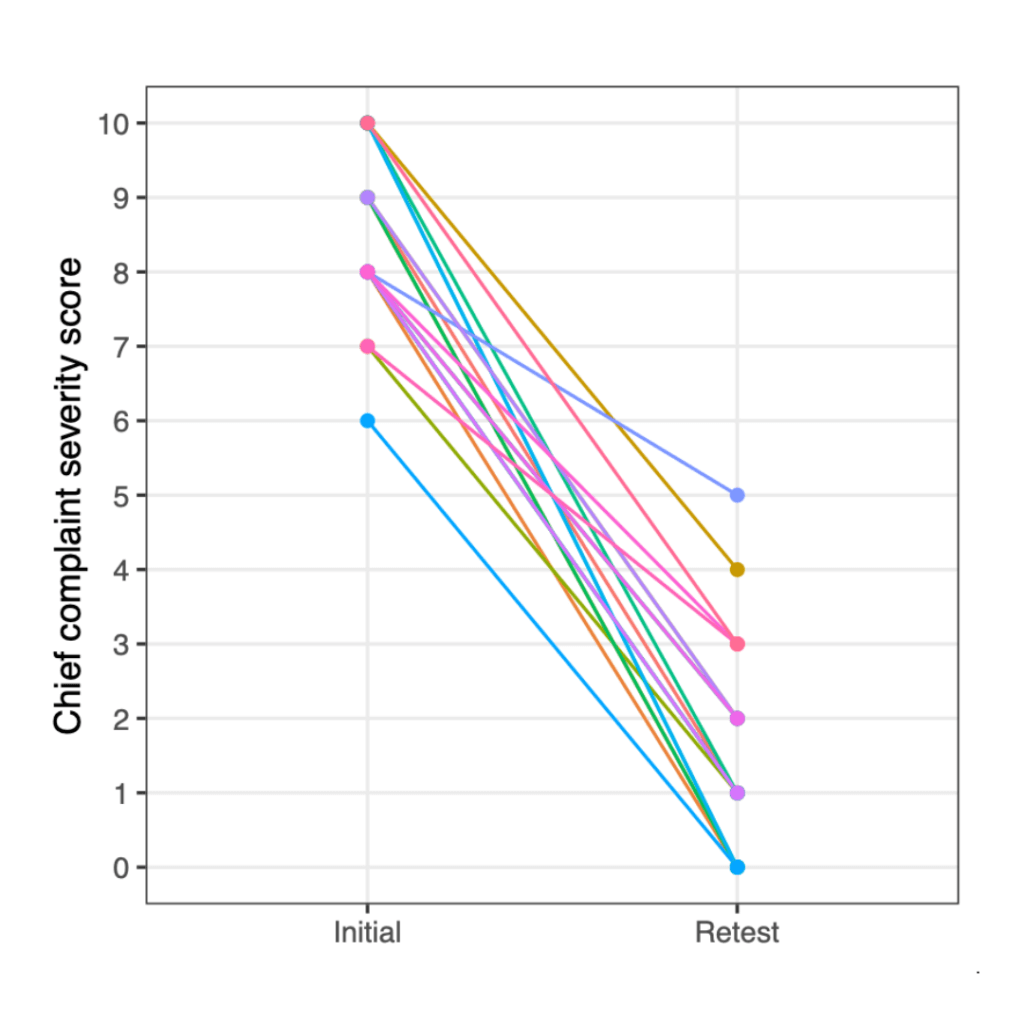
Severity scores explanation:
- Scale: 0 – 10
- 0 = complete resolution of chief complaint | 10 = severe symptoms
Data in Figure 2 shows the significant improvements in the chief complaint severity scores as reported by the patients before the initial test (baseline) and after the second test (retest). The differences seen between the two test results can be strongly presumed to be significant.
Figure 3.1
Chief complaint severity score comparison – initial and after retest
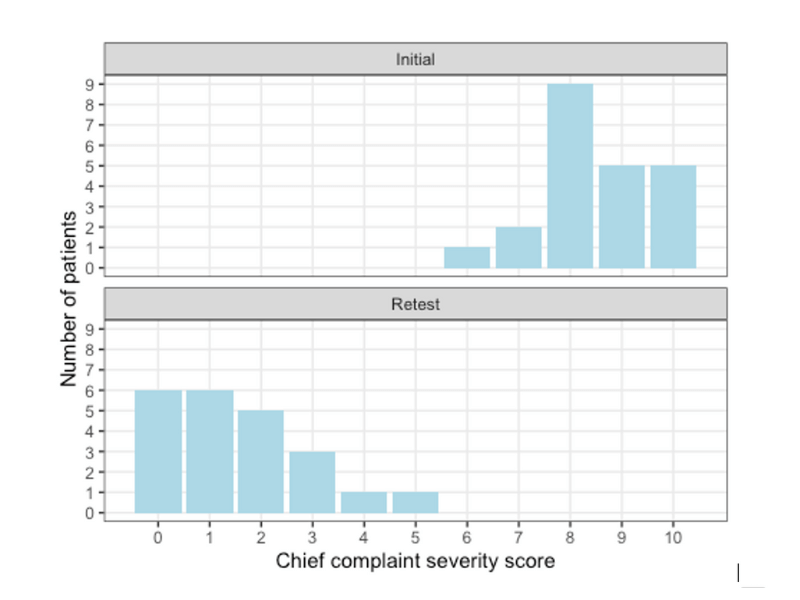
Severity scores explanation:
- Scale: 0 – 10
- 0 = complete resolution of chief complaint | 10 = severe symptoms
As can be seen in Figure 3.1, six patients reported a complete resolution of severe chief complaint(s) i.e. a score of 0. 2 patients reported a complete resolution of both chief complaint and other complaints. Therefore, the differences seen between the two test results can be strongly presumed to be significant. This was confirmed by the statistical analysis as described above.
Figure 3.2
Rating of overall improvement from baseline
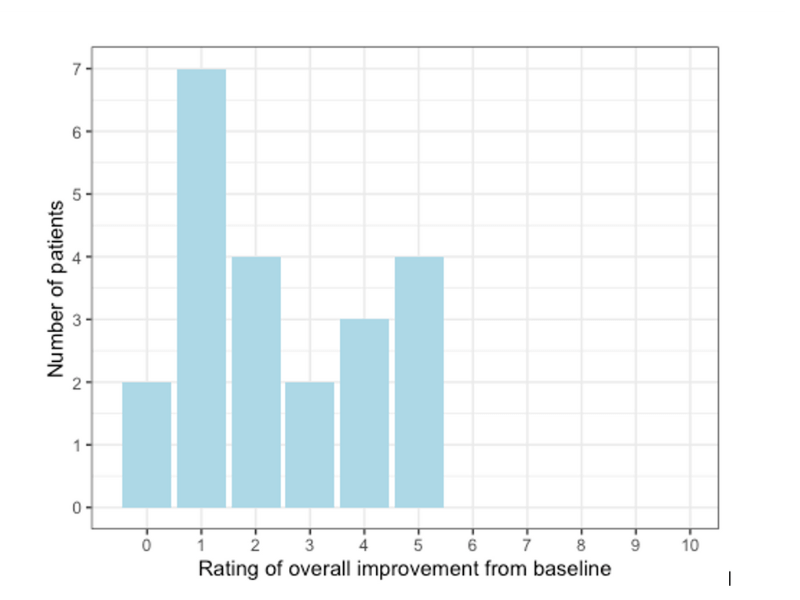
Severity scores explanation:
- Scale: 0 – 10
- 0 = complete resolution of chief complaint(s)
- 10 = severe symptoms
In addition to the significant improvements of chief complaint(s) in all participants, their other symptoms listed initially along the chief complaint(s) either resolved or significantly decreased – see Figure 4. We monitored the improvements in all reported symptoms by asking all participants to self-assess their overall health improvements by estimating an overall percentage improvement from baseline.
Figure 4
Overall improvements rating of all complaints or symptoms (%)
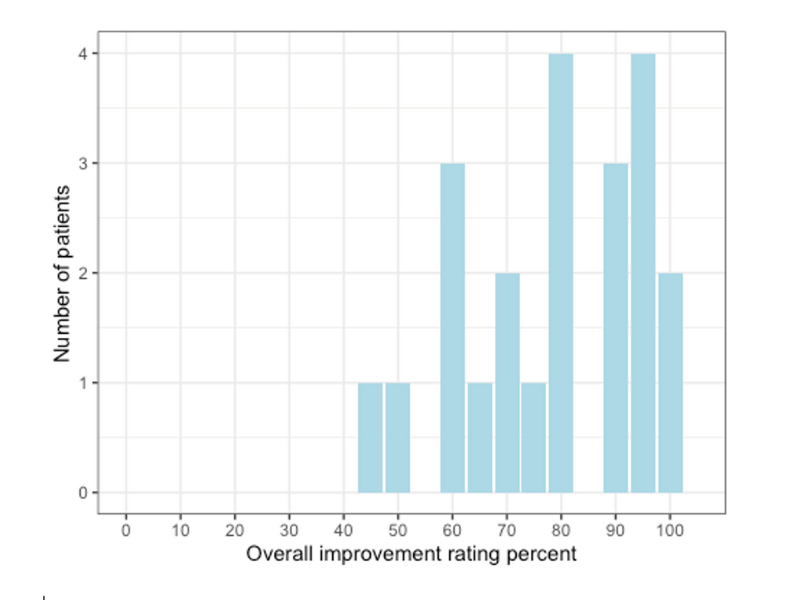
Figure 4 illustrates the following findings:
- 13 patients (59%) achieved at least 80% improvement in overall complaint(s) and/or symptoms
- 20 patients (91%) achieved at least 60% improvement in the overall complaint(s) and/or symptoms
Data analysis across all patient categories is presented in Figure 5.
Figure 5
Average overall improvement from baseline per category (%)
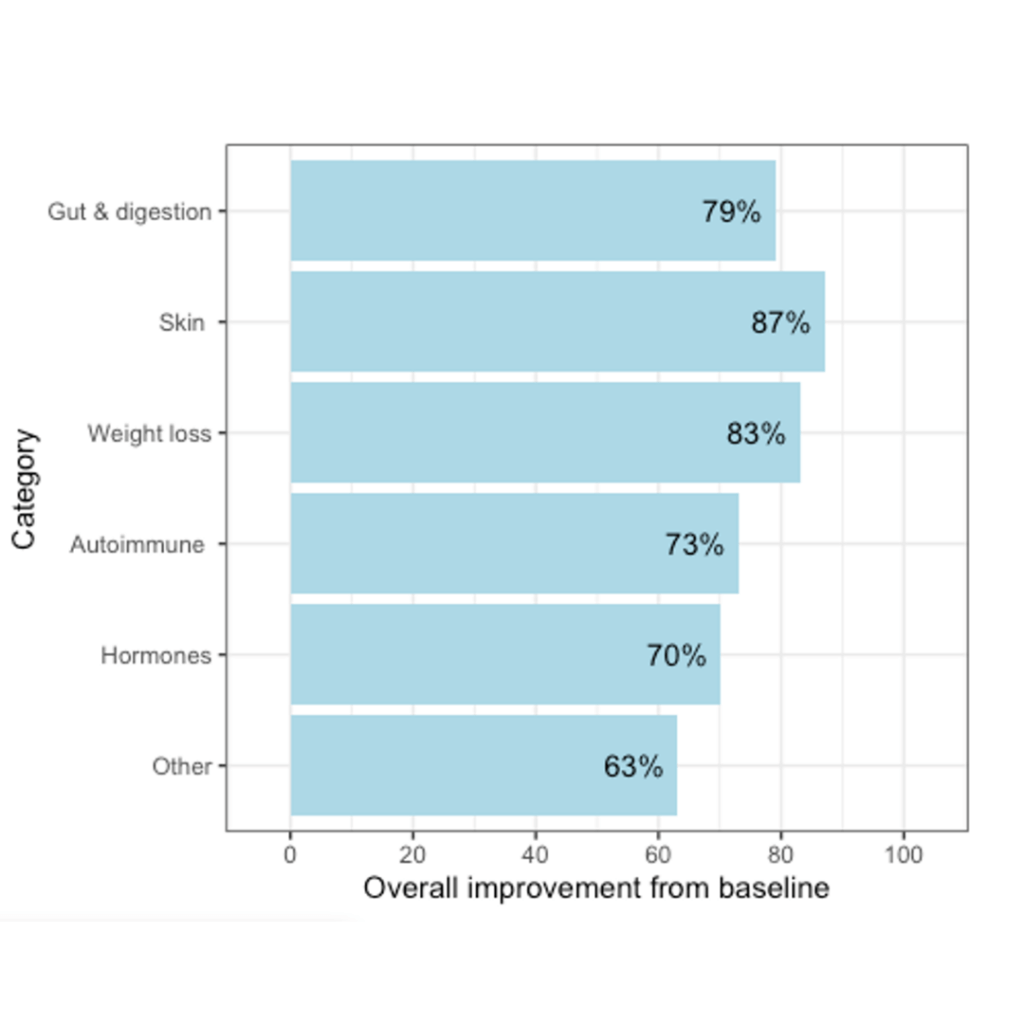
Category data analysis: Percentage improvements of combined chief complaint(s) and other monitored symptoms compared to baseline:
- Patients in all categories achieved at least 63% improvement from baseline
- Patients in the skin category achieved the most significant improvements – 87%. Notably, 40% of patients in this category achieved a complete resolution of symptoms
- Very good results were achieved in the following categories:
- Weight loss – 83% improvements with 50% achieving a healthy weight
- Gut and digestion – 79% improvements with 33% achieving complete resolution of symptoms
Sample case studies
We have documented patient’s steps and progress overtime in detailed case studies in each category. All case studies can be found HERE.
Individual links to sample case studies are listed below.
Obesity/ overweight
- Weigh loss and food sensitivities: Karen’s story
- How food sensitivities stop you from losing weight – a case study
- How to lose weight and keep it off – a case study
Gut disorders
- Optimal gut health diet plan – a case study
- How to improve gut health with the right foods – a case study
Skin conditions
- Eczema gut health and food sensitivities – a case study
- Eczema diet: foods to eat and avoid – a case studyOvercoming skin issues, bloating and excess weight – a case study
Autoimmune conditions
- Autoimmunity and food sensitivities – a case study
- Resolving pain, inflammation and arthritis – a case study
Hormones
Hormone imbalances: heavy periods, PMS, menopause
Conclusions
Despite the controversies surrounding IgG food sensitivity testing discussed in our study, more recent research and clinical studies suggest a link between IgG food sensitivities testing to identify possible food triggers, in order to develop personalised elimination diets for a wide variety of conditions and symptoms.
Our study demonstrated that patients’ health and wellbeing markedly improved when their food sensitivities decreased as a result of following a tailored elimination diet, demonstrating that food removal based on the IgG test results could be an effective approach to patients’ care. Patients who complied by avoiding foods in the elevated category (most patients removed all foods in the elevated and borderline categories) experienced significant improvements in their chief complaint(s) and other symptoms or complaints.
While traditional elimination diets are often utilised by practitioners, these are time consuming to implement and require patient’s daily commitment and discipline to notice, record and self-monitor potential food triggers. This process often proves challenging for both patients and practitioners. Therefore, IgG testing should be considered as an efficient, timesaving and cost-effective alternative.
Overall, the study results support the validity of the IgG tests in identifying the severity of food sensitivities and its effectiveness as a tool in clinical therapy, including the resolution and/or management of symptoms related to food sensitivities in the six diverse health categories utilised in the study. Food sensitivities testing and elimination diet can be an effective clinical tool to resolve many chronic symptoms.
Despite the efficacy of the IgG testing in showing the correlation between the magnitude of the IgG response and the reduction of symptoms after avoidance of the elevated foods, unanswered questions remain and need to be investigated further.
The next steps
Given the plethora of treatments and various formulations (conventional and natural) to alleviate or resolve symptoms of bloating, abdominal pain, diarrhea, constipation, fatigue, migraines, headaches, depression, joint pain, eczema and urticaria, weight loss, among others, the study has demonstrated a solid supportive data for considering the use of IgG food sensitivities tests in clinical interventions supporting patients with diverse symptoms and in lowering total inflammatory load.
As shown in our study, to make it effective, food sensitivity testing needs to be supported by working with patients on an individual basis and support them in implementation of the elimination diet. If you have been searching for an online gut naturopath or nutritionist helping clients based anywhere in Australia, please get in touch.
Book an online consultation now or click on the button below to book a free 25-minute initial discussion to talk about your circumstances and how I can help.
I look forward to helping you get better health and wellbeing soon!
Best of Health
Joanna Sochan
Wholistic Health and Lifestyle Therapist
Natural and Lifestyle Therapies for Abundant Health and Wellbeing
References
[1] Gaby A. Food allergy: Nutritional Medicine 2nd ed. Concord, NH: Frits Perlberg Publishing; 2017. Pp.23-30.
Our study is fully referenced, with 40 references provided to illustrate our findings.
Additional resources
- Optimal healthy gut diet – a case study
- Nature Heals Method
- Food sensitivities blogs by Naturimedica
Disclaimer: The above materials for informational and educational purposes only. It should not be used to self-diagnose and it is not a substitute for a medical advice, diagnosis, treatment, prescription or recommendation. All viewers of this content, especially those taking prescription or over-the-counter medications, should not make any changes in their health regimen or diet before first consulting a doctor or other qualified health provider with any questions they may have regarding a medical condition or their particular circumstances.
 Joanna Sochan is a Natural Therapist and founder of Naturimedica Wholistic Wellcare. She has a passion for helping clients transform their lives by becoming healthy and well naturally. Joanna has 12+ years experience in clinical practice and has special interest in solving complex cases, gut health, food sensitivities, hormone imbalances, autoimmune disorders and weight loss. She helps clients individually (mostly online) Australia-wide and also offers online therapeutic programs, eCourses and self-help eBooks. View full bio.
Joanna Sochan is a Natural Therapist and founder of Naturimedica Wholistic Wellcare. She has a passion for helping clients transform their lives by becoming healthy and well naturally. Joanna has 12+ years experience in clinical practice and has special interest in solving complex cases, gut health, food sensitivities, hormone imbalances, autoimmune disorders and weight loss. She helps clients individually (mostly online) Australia-wide and also offers online therapeutic programs, eCourses and self-help eBooks. View full bio.
 Print This Post
Print This Post 


Leave A Comment